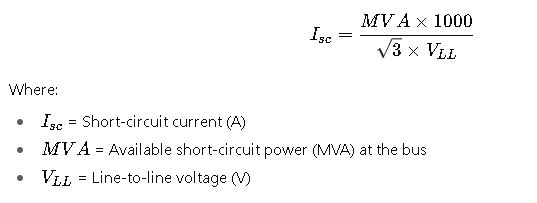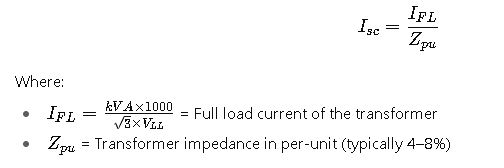The Breaker Interrupting Capacity (AIC), also called SCCR, defines breaker ability to withstand short-circuit currents. NEC requires every overcurrent protective device, including circuit breakers, to equal or exceed available fault current capacity.
Breaker Interrupting Capacity (AIC) Calculator — NEC
Quickly determine the minimum interrupting rating (AIC / kAIC) required for a breaker per NEC 110.9. Enter the maximum available fault current (MAFC), or compute MAFC from transformer data. Choose common commercial AIC options or a custom rating — the calculator will recommend the nearest safe device rating.
What is Interrupting Rating (AIC)?
How to compute MAFC from transformer data?
I_sc (A) = (Transformer kVA × 1000) / (√3 × V_line × (Z% / 100))
where V_line is transformer secondary line-to-line for 3Ø transformers (use L-N for single-phase).
Formulas used
– Transformer method (three-phase): I = (kVA·1000) / (√3·V·(Z%/100)).
– Required AIC = MAFC × safety margin; then optionally round up to nearest commercial AIC.
Understanding Breaker Interrupting Capacity
The interrupting capacity is defined as the maximum prospective short-circuit current a breaker can safely interrupt without damage. For example:
- A 10 kAIC breaker can interrupt up to 10,000 amperes of fault current at its rated voltage.
- If the available fault current at the installation is 22,000 amperes, a 10 kAIC breaker would be inadequate, and a breaker rated at 22 kAIC or higher must be installed.
The NEC mandates this requirement in Article 110.9 (Interrupting Rating) and Article 110.10 (Circuit Impedance, Short-Circuit Current Ratings, and Other Characteristics).
Common Breaker Interrupting Ratings
The table below provides the most common interrupting capacity ratings for low-voltage circuit breakers, as used in North America under NEC standards.
| Breaker Type | Common Voltage Classes | Standard Interrupting Ratings (AIC) | Typical Applications |
|---|---|---|---|
| Molded Case Circuit Breaker (MCCB) | 120V / 240V / 480V / 600V | 10 kAIC, 14 kAIC, 22 kAIC, 35 kAIC, 42 kAIC, 65 kAIC, 100 kAIC | Commercial panels, branch circuits |
| Miniature Circuit Breaker (MCB) | 120V / 240V | 5 kAIC, 10 kAIC, 14 kAIC | Residential and light commercial |
| Insulated Case Circuit Breaker (ICCB) | 480V / 600V | 65 kAIC, 85 kAIC, 100 kAIC | Industrial feeders and switchboards |
| Low Voltage Power Circuit Breaker (LVPCB) | 480V / 600V | 50 kAIC, 65 kAIC, 85 kAIC, 100 kAIC, 150 kAIC | Large switchgear assemblies |
| Fused Disconnect (Class J, RK, L) | 240V / 480V / 600V | 200 kAIC (typical with current-limiting fuses) | High-fault industrial systems |
Note: Interrupting capacity must be verified at the system voltage, since the rating is not always identical at 240V vs. 480V.
Essential Formulas for Breaker Interrupting Capacity Calculations
Although many engineers rely on software such as ETAP, SKM, or EasyPower, the fundamental formulas for estimating fault current and breaker AIC can be applied manually.
1. Three-Phase Symmetrical Fault Current (at transformer secondary)

2. Transformer-Based Fault Current Approximation

3. Equivalent Impedance Method
For networks with multiple sources or feeders:

4. Single-Phase Fault Current (Line-to-Neutral)

Common Values of Variables
| Variable | Typical Range / Value | Notes |
|---|---|---|
| Transformer %Z | 4% – 8% | Large industrial: 5.75% common |
| System Voltage | 120V, 208V, 240V, 480V, 600V | NEC low-voltage ranges |
| Fault Current | 5 kA – 200 kA | Depends on system capacity and proximity to utility |
| Breaker AIC Ratings | 5 kAIC – 200 kAIC | Select nearest standard above available fault |
Expanded Reference Table: Fault Current at Transformer Secondary
Below is a reference table for fault current values based on transformer kVA, impedance, and voltage (per-unit calculation basis).
| Transformer Size (kVA) | Voltage (V) | %Z | Full Load Current (A) | Available Fault Current (kA) |
|---|---|---|---|---|
| 500 kVA | 480 V | 5.75% | 602 A | 10.5 kA |
| 750 kVA | 480 V | 5.75% | 902 A | 15.8 kA |
| 1000 kVA | 480 V | 5.75% | 1203 A | 21.1 kA |
| 2000 kVA | 480 V | 5.75% | 2405 A | 42.1 kA |
| 2500 kVA | 480 V | 5.75% | 3006 A | 52.6 kA |
| 3000 kVA | 480 V | 5.75% | 3607 A | 63.1 kA |
| 5000 kVA | 480 V | 5.75% | 6012 A | 105 kA |
This table highlights how available fault current increases rapidly with transformer size, making breaker AIC ratings critical.
NEC Requirements for Breaker AIC
The National Electrical Code (NEC 2023) requires the following key points:
- NEC 110.9 – Interrupting Rating
- OCPDs must have an interrupting rating not less than the available fault current at the point of installation.
- NEC 110.10 – Circuit Impedance and Short-Circuit Protection
- The protective devices must protect both equipment and conductors from damage.
- Proper coordination with conductor impedance and equipment SCCR must be ensured.
- NEC 240.86 – Series Ratings
- In certain cases, series ratings (combining upstream and downstream breakers) may be applied if tested combinations are used.
- NEC 409.22 – Industrial Control Panels
- Panels must be marked with a short-circuit current rating (SCCR).
Real-World Application Examples of Breaker Interrupting Capacity Calculations
The following case studies illustrate how the Breaker Interrupting Capacity Calculator – NEC is applied in real projects. These scenarios are based on actual engineering practice, highlighting the risks of incorrect selection and the importance of compliance.
Case Study 1: Commercial Building Service Entrance
Scenario:
A new 12-story commercial office building is being designed with a 2000 kVA transformer (480V, 5.75% Z) feeding the main switchboard.
Steps:
- Utility Data Review
- The utility provides available short-circuit power at the primary.
- After conversion, the calculated fault current at the secondary terminals is ~42 kA.
- Breaker Evaluation
- The main breaker is specified at 65 kAIC.
- Branch breakers feeding panelboards are rated 22 kAIC.
- Problem Identification
- A tenant distribution panel is located close to the transformer.
- The available fault current at this location is estimated at 40 kA.
- The panel breakers specified are only 22 kAIC.
- Solution
- The design team considers two options:
- Replace with fully rated 42 kAIC breakers (more costly).
- Apply series rating (65 kAIC main breaker + 22 kAIC branch) using UL-listed combinations.
- The design team considers two options:
- Final Decision
- The engineer documents a series rating combination approved by the manufacturer and NEC 240.86.
- Labeling is applied to warn against substitution of breakers.
Lesson Learned:
Even in commercial projects, fault current values near large service transformers can exceed 20–30 kA. Designers must evaluate series ratings vs. fully rated systems early in the design phase.
Case Study 2: Industrial Manufacturing Plant
Scenario:
An industrial plant installs a new 480V motor control center (MCC) fed from a 2500 kVA transformer with 5.75% impedance.
Steps:
- Initial Fault Current Estimate
- Available fault current at the MCC is approximately 52.6 kA.
- Breaker Inventory
- The MCC ships with 35 kAIC molded case breakers.
- This rating is insufficient because the available current exceeds 50 kA.
- Engineering Decision
- Three possible approaches:
- Upgrade all breakers to 65 kAIC (significant cost increase).
- Apply current-limiting fuses upstream to reduce let-through current.
- Use series rating combinations validated by the manufacturer.
- Three possible approaches:
- Implementation
- The plant elects to use current-limiting fuses (Class J, 200 kAIC) at the feeder level.
- This reduces the available fault current seen by downstream breakers to within their 35 kAIC rating.
- Verification
- Coordination studies are performed to ensure fuse operation does not trip during motor starts.
- Labels are applied per NEC 110.22 to indicate protective device coordination.
Lesson Learned:
Industrial systems often exceed 50 kA available fault current. Without mitigation (fuses or higher-rated breakers), equipment may not comply with NEC 110.9.
Series Ratings vs. Fully Rated Systems
When fault current exceeds the rating of standard breakers, designers face two main strategies:
- Fully Rated Systems
- Every breaker has an interrupting rating ≥ available fault current.
- Provides maximum flexibility for future modifications.
- Higher upfront cost (special high-AIC breakers).
- Series Rated Systems
- A lower-rated downstream breaker is paired with a high-AIC upstream breaker.
- The upstream device absorbs the majority of fault current.
- Allowed under NEC 240.86, provided it’s tested and documented.
- Less expensive but restricts breaker replacement to manufacturer-approved combinations.
Best Practice:
For large industrial systems, fully rated breakers are preferred. For commercial systems with cost constraints, series ratings can be acceptable if properly documented.
Practical Considerations in Breaker Selection
- Coordination Studies
- Time-current coordination ensures upstream breakers trip only after downstream devices fail to clear faults.
- Labeling Requirements
- NEC requires panels and equipment to be labeled with the available fault current and date of calculation (NEC 110.24).
- Future Capacity Planning
- Available fault current may increase if the utility upgrades service transformers.
- Breaker selection should consider future fault current growth.
- Arc Flash Studies
- Higher available fault current can increase incident energy.
- Coordination between breaker AIC ratings and NFPA 70E arc flash labeling is critical.
Benefits of Using a Breaker Interrupting Capacity Calculator
- Accuracy: Prevents under-sizing breakers.
- Compliance: Ensures NEC Article 110 and 240 compliance.
- Cost Optimization: Identifies when series ratings can be applied instead of costly fully rated breakers.
- Safety: Reduces the risk of catastrophic breaker failure.
- Documentation: Provides traceable results for inspection and maintenance
